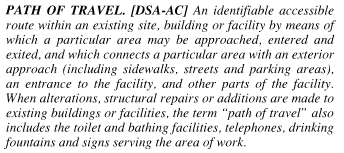Yikes
SAWHORSE
So I talked to a DSA staffer today on yet another alteration project, asking them whether an alteration that provides all 5 items in 11B-202.4 also has to make parking accessible, even though it isn't mentioned as one of the 5 items.
The staff said "yes, that's our interpretation". I pointed our that the code doesn't explicitly say that, and I asked him how they could arrive at an interpretation that exceeds code.
He conceded that 202.4 was poorly written if the intent was to require parking.
They hang their hat on the CBC 202 definition of "Path Of Travel" where it says that a path of travel "connects a particular area with AN [singular, not plural] exterior approach (including sidewalks, streets, and parking areas), an entrance to the facility, and other parts of the facility."

I pointed out that we have "an" (one) POT from the public sidewalk through the accessible entry door and to the area of alteration. So why would we need a second POT from the parking. He responded that the way they interpreted it, it was all one big route, akin to spokes on a wheel all being part of one wheel.
I would counter that if that is how they interpret CBC 202 definition of path of travel, then this hub-and spoke definition must include not only accessible "parking areas" but also accessible "sidewalks" and accessible "streets", which of course belong to the city. When was the last time you saw an office remodel become responsible to provide an "accessible street"?
Furthermore, even if you agree with DSA's reach on this interpretation, it does not say the parking space(s) needs to be accessible - - it only says the path to the parking area needs to be accessible. You could have a path going right to the edge of the parking lot, with no accessible parkign, and the requirement would be fulfilled.
The staff said "yes, that's our interpretation". I pointed our that the code doesn't explicitly say that, and I asked him how they could arrive at an interpretation that exceeds code.
He conceded that 202.4 was poorly written if the intent was to require parking.
They hang their hat on the CBC 202 definition of "Path Of Travel" where it says that a path of travel "connects a particular area with AN [singular, not plural] exterior approach (including sidewalks, streets, and parking areas), an entrance to the facility, and other parts of the facility."

I pointed out that we have "an" (one) POT from the public sidewalk through the accessible entry door and to the area of alteration. So why would we need a second POT from the parking. He responded that the way they interpreted it, it was all one big route, akin to spokes on a wheel all being part of one wheel.
I would counter that if that is how they interpret CBC 202 definition of path of travel, then this hub-and spoke definition must include not only accessible "parking areas" but also accessible "sidewalks" and accessible "streets", which of course belong to the city. When was the last time you saw an office remodel become responsible to provide an "accessible street"?
Furthermore, even if you agree with DSA's reach on this interpretation, it does not say the parking space(s) needs to be accessible - - it only says the path to the parking area needs to be accessible. You could have a path going right to the edge of the parking lot, with no accessible parkign, and the requirement would be fulfilled.
Last edited:
